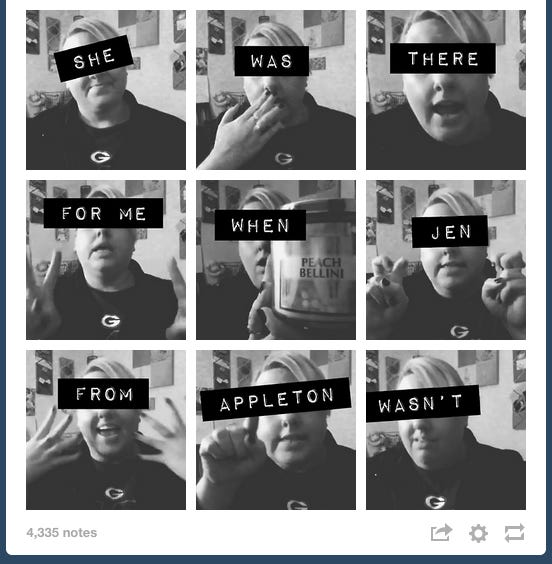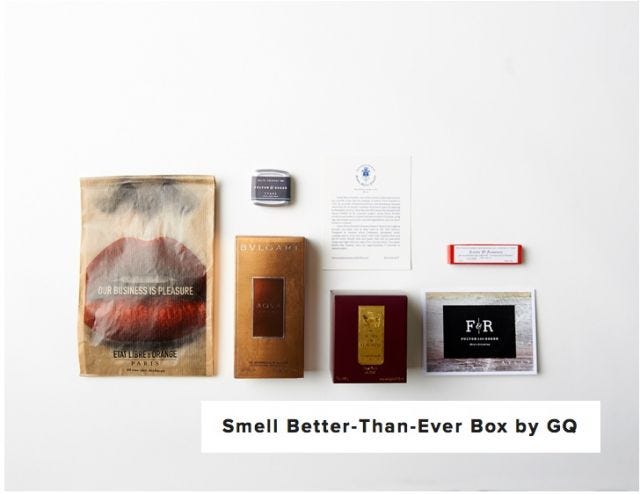So What, Who Cares (vol 1, issue 34) Why subscription boxes are a substitute for magazines

Today I watched a YouTube video by someone who has a intense emotional investment in whether or not Bath & Body works has the right scented candles, and once I was done, YouTube was kind enough to point me to a video in which this same citizen crusader got a little worked up over the contents of her Birchbox subscription. Angela has strong ideas as to what is appropriate for a monthly subscription. Bless her for sharing with the rest of us.
*
Unboxing, or the act of unwrapping a new product and reacting in real time to the item, is not a new video genre. As the hours spent watching unboxing videos pile up (YouTube viewers watch six billion hours a month of unboxing footage), so do the number of people attempting to explain the appeal. The explanations vary: "Everything from consumers’ taking back the night from untrustworthy marketers, to shoppers’ trying to humanize increasingly computer-based shopping through sharing, to aspirational thrill-seeking in recessionary, digitally mediated times." Some even suggest that unpacking a new product is a ritualistic experience, one that makes the product feel special.
Coincidentally, there has been a rise in subscription boxes. Remember Columbia House Record Club? The idea of paying money to get random goods you don't select in the mail has been radically expanded in the age of e-commerce. People can now sign up to receive regular shipments of everything from adult toys to arts-and-crafts kits, from cosmetics to clothing, from healthy snacks to pot-smoking paraphernalia, from children's toys and game to chili. The allure of a subscription box is two-fold: Cool stuff comes to your house that you don't have to find or fetch on your own, and that cool stuff is perceived to cost about 30% less than it would if you did take the time to find it in a store.
Because so many of the businesses are private and under no obligation to reveal revenue, it's difficult to gauge the monetary scale of the retail niche they occupy. But the subscription box niche has already hit one major milestone in retail: A site aggregating user reviews from subscribers endorsing some services and torpedoing others.
So what? Subscription boxes solve problems for two different industries. If an online retail experience isn't carefully designed, consumers are going to be overwhelmed by too many choices and they'll leave without buying. A subscription box eliminates consumer choice but keeps the "money exchanged for goods and services" angle of retail.
It also offers the illusion of a luxury experience, i.e. the products are "curated" for you in a simulacra of the personal-shopper experience. (That the shopper here is an algorithm reacting to your data profile is beside the point.) Luxury is a license to charge the shopper more -- or a way to expand a customer base to middle-tier and lower-end shoppers who will happily consume fast fashion if it comes in the mail wrapped in a guarantee of "personal" styling. And subscription boxes are a great way for traditional retailers to reach a new audience: there's a reason why Nordstrom's paid $350 million for menswear subscription box Trunk Club last summer.

Subscription boxes may also be a way for publications to maintain or expand their presence in the modern media landscape. One advantage print magazines have over their digital brethren is a tactile quality: Why not reinforce that with an audience that's already primed for regular packages in the mail? The subscription box service Quarterly actually uses the magazine metaphor, calling the people who select a package's content "contributors" and referring to individual packages as "issues." Quarterly founder Zach Frechette (formerly of GOOD magazine) says that the subscription box is like a magazines because of the following elements: the snail-mail delivery; the tactile, physical quality of the goods; the sense that the "issue" is a reflection of the recipient's self-identified tastes and values.
This may explain why Design Sponge -- whose founder, Grace Bonney, has not been shy about her desire to produce a magazine of her own OR about discussing the massive financial upheaval taking place in the shelter blog industry -- is rolling out a $100-per-quarter "issue" with Quarterly. It's a great way to expand the brand beyond the blog and co-opt that fun-in-the-mailbox magazine thrill.
Who cares? Look at the industry ripples the boom in subscription boxes create: There's data mining to be done (and therefore consumer profiles to be sold). There's inventory management and shipping logistics -- so, lots of exciting software opportunities there and lots of opportunities for players in the shipping sector. There are already services that help you launch your own subscription box. Couple a suite of DIY subscription-box tools with the Maker Movement, and you've got a retail model that can serve small-scale creators, cooks, curators or chambers of commerce pushing local charm. It's also a retail model that doesn't require commercial real estate or the infrastructure around traditional bricks-and-mortar retailers.
Consider how subscription boxes reinforce the idea that a customer's first point of entry into a retail experience is online, and they don't have to go to a store. It's not a big leap from Birchbox (for treats) to Amazon Subscribe + Amazon Prime (for everyday toiletries) -- and every shopper who does that is one less shopper making a weekly trek to a big-box store.
Finally, to bring it all back to unboxing videos: Consider how a customer's first exposure to a brand might be when it's thrust upon them by their favorite subscription service. Consumer how eagerly people engage with their latest postal treasures online. There's a relationship to be built between brand and customer here; it'll be interesting to see how it plays out.
*
Did you miss an issue of So What, Who Cares? The archive is here. Also, there is now a topic index that tells you what was in each issue. If you're like, "I remember there was an issue with otters in it, but when ...?" -- well, now you can find it. (It was September 24, btw.)
As always, I welcome your feedback and suggestions via email or Twitter. Always let me know what you think about So What, Who Cares? If you really like it, tell a friend to subscribe.

